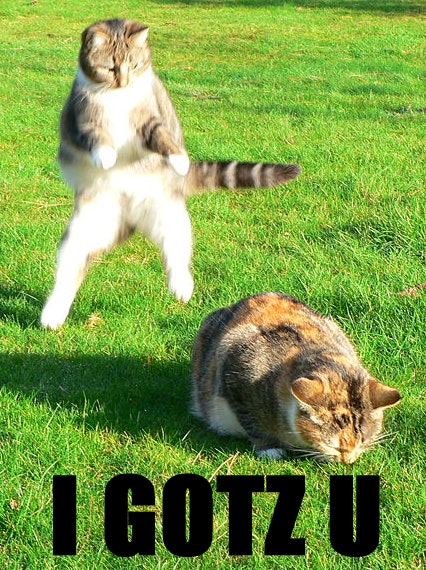Cuteness Is in the Eye of the Beholder

Facing environmental crises like climate change, the poet Isabel Galleymore asks us to consider how our view of nature shapes what we believe is worth protecting.
Have you ever been scrolling through Instagram and stumbled across a video of a kitten playing or staring wide-eyed into the camera? That video leads to another—perhaps of a floppy-eared puppy or a fuzzy duckling—and before you know it, 20 minutes have slipped away.
Encountering cuteness is an everyday experience, says Isabel Galleymore, the 2022–2023 Walter Jackson Bate Fellow at Harvard Radcliffe Institute. It infiltrates our lives in the form of viral videos, pets, Disney characters, fashion trends, and more, producing feelings of comfort, joy, and care.
Galleymore, an associate professor in creative writing at the University of Birmingham, in the United Kingdom, became interested in this phenomenon while working on a PhD at the University of Exeter. She was studying nature writing and exploring ecopoetics.
Galleymore noticed that anthropomorphism—attributing human characteristics to animals—was often characterized as a “dirty word.” She decided to investigate this discomfort by exploring its most extreme manifestation, what she refers to as “cutification.”
Galleymore is working on a second poetry collection that builds on her debut collection Significant Other (Carcanet Press, 2019) and further explores our relationship with nature and its creatures, especially the role of cuteness.
What is Cuteness?
To be cute is to be “attractive or pretty especially in a childish, youthful, or delicate way.” Childish. Youthful. Delicate. It bestows a sense of smallness and vulnerability, says Galleymore, which prompts a caregiving response. Cuteness (like poetry) is often associated with sentimentality and softness, even femininity (which is problematic in its own right).
Writing about Cuteness
The wild turkeys that Galleymore has encountered wandering around Cambridge, a recent trip she took to Disneyland Paris (strictly for research, of course), and the poetry of D. H. Lawrence all fuel her creative process. She has even attempted to write poetry in LOLcats, a type of meme that consists of misspelled text superimposed over images of cats.

Example of a lolcat meme. Image by Hersfold; derived image from File: Worak - Attack (by).jpg. Courtesy of Wikimedia Commons.
In Significant Other, Galleymore represents nature and its creatures with rapt attention to detail, without slipping into nostalgia or glorification. She doesn’t shy away from more gruesome aspects, challenging us to expand our ideas of what is worth marveling at. Take, for example, Galleymore’s account of a starfish eating a mussel in “The Starfish” (reproduced below), which meticulously documents the entire procedure.
The Starfish
creeps like expired meat –
fizzy-skinned, pentamerously-legged,
her underfur of sucking feet
shivers upon an immobile mussel
whose navy mackintosh is zipped
against the anchor of this fat paw,
this seemingly soft nutcracker who exerts
such pressure until the mussel’s jaw
drops a single millimetre. Into this cleft
she’ll press the shopping bag of her stomach
and turn the mollusc into broth,
haul in the goods and stumble off,
leaving a vacant cubicle,
a prayer come apart.
Another poem, “Examples Include Celine Dion’s ‘My Heart Will Go On’” goes a step further, exploring themes of commodification, sentimentality, and kitsch, highlighting the comfort that cuteness brings us while at the same time reminding us of the environmental consequences of the, presumably plastic, “toy ring with little kitten’s face” that endures “decade after decade.”
Examples Include Celine Dion’s “My Heart Will Go On”
The toy ring with little kitten’s face
loves the world so very much!
Child’s room, roadside, ocean floor…
decade after decade, it can’t tear itself away!
When the world comes home tired,
the toy ring with little kitten’s face
is the pink and heart-shaped post-it note,
is the bunch of petrol-station flowers
one person gives another as they imitate
the hard-wearing infatuation
of the toy ring with little kitten’s face.
Oh people in their cars and kitchens
singing of forever and always…
Really! You have to feel for them.
Cuteness and Conservation
So how might our projections of cuteness affect our perception of and interactions with the natural world? Galleymore suggests that cuteness breaks down the boundaries between nature as “out there” or “outdoors” versus culture as “in here” or “indoors.” It disrupts the conceptual separation created by traditional representations of (capital N) Nature as something “other” that inspires awe, as in the writings of Romantic poets such as Wordsworth, Keats, and Blake. “There’s this kind of reverent quality that comes up often in writing about the environment,” says Galleymore. These poets depict Nature as grand, sublime, pristine, frighteningly powerful, and supremely beautiful.
Now, contrast this attitude toward Nature with the familiar way we think of our pets: how we invite them into our spaces and attribute human characteristics to them. Perhaps we might promote environmental protection then, by encouraging people to view more plants and animals, or even the globe as a whole (think “blue marble”), as cute? Perhaps we might provoke a caring response by generating a sense of closeness and affection?
The Dark Side of Cuteness
One potential problem with attempting to encourage environmental protection by depicting endangered species as cute is that not all species lend themselves to cutification. Galleymore points out that some endangered species (sometimes called charismatic megafauna), such as the panda bear, have characteristics that humans readily find cute. Others, like the Alameda whipsnake or the valley elderberry longhorn beetle, lack many of these characteristics. How then, do we protect species that we find ugly, scary, gross, or otherwise unappealing?
There has been some progress in this regard. Galleymore cites films like A Bug’s Life (1998) and Bee Movie (2007), which have created charismatic characters out of ants and bees—creatures often seen as pests. Perhaps with the right communications strategy we can expand our sense of cute species to include all species that need protection. But there is danger in that as well.
“The kind of love that we feel with a cute object or animal can easily become one of mastery rather than a more innocent form of love,” says Galleymore. This power differential makes us feel in control of cute animals or objects and might lead us to disregard their needs and wants. We might feel that we know what’s best for the cute subject better than the subject itself (think of parents making decisions for their children) and decide to take matters into our own hands for the cute subject’s supposed benefit. But do we always know what’s best for endangered species? And what happens when this strange adoration turns into commodification?
Some studies warn us against the “Nemo Effect”—an increase in the purchase as pets of animals featured in films like Finding Nemo. Although evidence for this phenomenon is inconclusive (other studies have suggested that, conversely, Finding Nemo encouraged viewers to protect wild clown fish rather than purchase them as pets), the Nemo Effect points to a deeper theoretical problem: Why should humans be the arbiters of which species survive and which don’t? Why should we primarily seek to protect species that we find appealing or relatable? The danger in anthropomorphizing species in order to save them is that we might inadvertently condemn those species that we can’t cutify, without taking into account more important factors, such as whether or not they are keystone species. “To some degree it might be useful, in our cultural ecological moment, for us to begin to push back against cuteness—be aware of its manipulations of us,” says Galleymore.
Going Forward
The Living Planet Index reported an estimated 58 percent decline in vertebrate biodiversity between 1970 and 2012, and current rates of species extinction are around 100 to 1,000 times higher than background rates. Climate change compounds the effects of other factors—such as pollution, habitat destruction, and hunting—on biodiversity loss, making species conservation an especially timely issue.
One point of poetry is to raise more questions than it answers. So, should we continue to cutify endangered species, or will that strategy eventually come back to bite us (pun intended)? More broadly, how does the way we represent different species affect how we treat them?
And most important, how do we preserve biodiversity equitably and without setting ourselves up as adjudicators of life and death?
Sam Zuniga-Levy is the communications coordinator at Harvard Radcliffe Institute.







